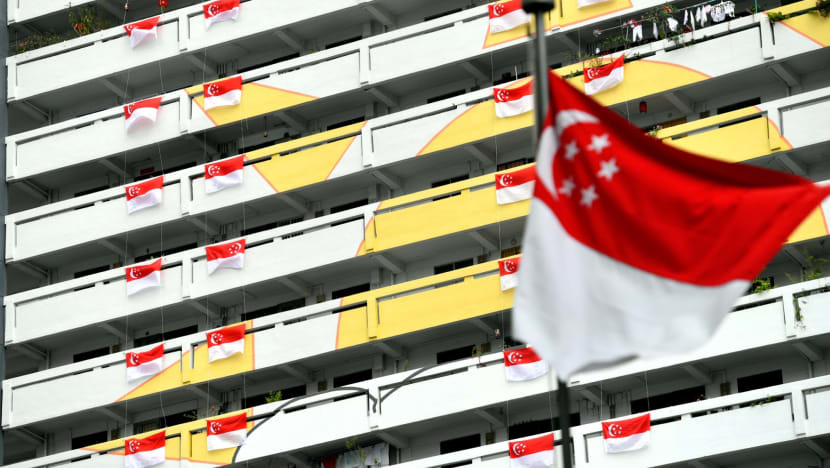Commentary: Will changes to national flag rules encourage more Singaporeans to display it?
It seems that fewer Singapore households these days display the national flag. Dr Leong Chan-Hoong of Kantar Public looks at what the national symbols mean to Singaporeans and how they can be made more relatable.

File photo of Singapore flags on an HDB block. (Photo: Jeremy Long)
SINGAPORE: National Day is traditionally a period of collective reflection. Every year, we look back on our past and consider what lies ahead of us.
This year is no exception. Given the polarised and divisive world today, issues of confidence and cohesion have never been more important as we navigate multiple global crises.
The rules governing the use of the national flag were recently eased.
With the Minister for Culture, Community and Youth's authorisation, the Singapore flag may now be put up at home outside of the National Day period for a gazetted time, for example, when athletes win medals in international sports. It can also be displayed without a flagpole and illumination at night.
The new regulations aim to empower Singaporeans to express their pride and solidarity with fellow citizens.
While it is too early to conclude if this framework can lead to a behavioural change, it is worthwhile to distil the meaning of national flags and their psychological impact on individuals.
NATIONAL FLAG AS A SYMBOL
The national flag is a cultural symbol that plays a pivotal role in shaping nationhood, identity and a sense of belonging. Throughout history, a profound sense of pride and patriotism is unfailingly evoked when a flag is raised.
The flag of United Kingdom for instance, combines the crosses of England and Wales, Scotland, and Ireland under one sovereignty. The flag projects a vision of a unity in spite of historical tensions between the regions.
Similarly, the flag of the former Soviet Union depicts a hammer and sickle to represent the interests of workers and peasants, who were once the constituents in the founding of the communist bloc.
The Singapore national flag comprises a crescent moon and five stars. The former signifies a young country, and the latter represents the ideals of Singapore: Democracy, justice, peace, progress and equality. These are the core values that define Singapore citizenship and our social compact.
WHAT NATIONAL FLAGS MEAN TO PEOPLE
National flags can evoke honour and patriotism, but they can also foster nationalist sentiment and prejudicial attitudes.
A 2017 study, published in the Journal of Cross-Cultural Psychology by me and my international colleagues, asked 2,230 university students across 11 countries what concepts they associate their national flags with.
While US respondents linked the American flag with democracy and freedom, they also ascribed less positive attributes such as global power, hegemony and aggression to it - a result of the US’ overseas military operations where the flag is planted on foreign soil.
In contrast, Singapore respondents connected the national flag with conformity and obedience, as well as honour and tradition. The survey findings suggest while people in Singapore subscribe to conservative values, they also endorse benevolence.
ENGAGING WITH THE SINGAPORE FLAG
Anecdotes on social media note a seemingly lacklustre interest in flying the national flag in recent years. A few lamented not seeing a single flag displayed at their neighbours’ homes, be it in HDB or private estates. One even quipped that inflation had affected the sale of flags.
There are a few plausible theories that explain these observations.
First, if we associate the national flag with authority and reverence, it would not be an object that we naturally find endearing at home.
Second, we have been conditioned to show patriotism only in state occasions and formal ceremonies, such as at National Day parades. Without positive reinforcement from authorities, it is not likely that families will display national symbols at home.
Third, the spontaneous demonstration of nationalistic affect is not a cultural norm practised here. This emotional deficit is cemented by the emphasis our society places on compliance and self-restraint.
FOSTERING OWNERSHIP OF NATIONAL SYMBOLS
To promote a deeper connection with national symbols - the flag included - we could consider expanding the range of occasions and locations where it can be used.
In Singapore, the discourse on the use of national symbols is deeply concentrated on achievements, be that economic development or sporting success.
But national symbols also provide solace and a sense of continuity in times of grief and loss.
In the US, this includes the aftermath of natural and man-made disasters like a hurricane or shooting. Survivors raise the American flag at their home compound as a sign of solidarity and resilience.
In Singapore’s context, can the national flag be displayed at memorial halls that mourn for the passing of eminent community leaders, such as that of the late Sim Wong Hoo and Law Society president Adrian Tan?
National symbols become relatable to people when they are interwoven with their daily lives. With time and opportunities, Singaporeans can forge a deeper connection to the crescent and five stars in our national flag.
Dr Leong Chan-Hoong is Head of Policy Development, Evaluation and Data Analytics at Kantar Public, a global policy advisory firm.




















